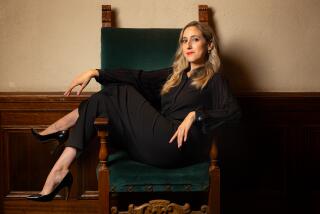‘FORCE FIELD’ REVISITED BY THE JOFFREY
Sometimes dance history, like dance itself, becomes surprisingly nonlinear.
Just a year and a half ago, Laura Dean’s “Force Field” represented the very last word in galvanic group propulsion and intricate, large-scale physical counterpoint: a relentless dance reflecting relentless music (Steve Reich’s “Six Pianos”). But that was before the Joffrey Ballet reconstruction of the original, long-lost “Le Sacre du Printemps,” a work that demands that we reconsider our assessments about choreographic development in the last 75 years.
Consequently, when “Force Field” reentered the Joffrey repertory Wednesday in the Dorothy Chandler Pavilion, it seemed--after “Sacre”--unexpectedly easy on the eyes and easy on the company as well. Vaslav Nijinksy had pulled Laura Dean into the ballet mainstream.
Beginning with twisting arms and expanding to a complex interlacing of ballet and postmodern vocabularies, “Force Field” aims at nothing more than being a divertissement for the late ‘80s. However, its sense of secular ritual sometimes transforms the 20 dancers into something greater than themselves, as if they are suddenly pure energy, pure light.
Beatriz Rodriguez and Philip Jerry often lead the ensemble, and as often provide a relatively conventional classical contrast to the modular, multidisciplinary athleticism of the ensemble. Nonstop, kaleidoscopic, eclectic, “Force Field” is bracingly contemporary, yet also reflects structural and kinesthetic principles that Nijinsky pioneered in 1913.
Few other companies than the Joffrey could dance “Force Field” with the drop-dead authority shown Wednesday and even fewer companies could offer audiences a repertory revealing the antecedents for this kind of choreographic achievement.
The Wednesday program also supplied a second look at Gerald Arpino’s neo-Romantic showpiece, “L’Air d’Esprit,” new to Los Angeles--this time danced by Tina LeBlanc and Glenn Edgerton. Both proved far more stylish than the first cast, though their partnership occasionally fell prey to mischance.
In the lead role in James Kudelka’s spiritual dance-drama, “Passage,” Ashley Wheater showed a new refinement of phrasing and a mastery of the ballet’s grueling flow of movement.
More to Read
The biggest entertainment stories
Get our big stories about Hollywood, film, television, music, arts, culture and more right in your inbox as soon as they publish.
You may occasionally receive promotional content from the Los Angeles Times.










